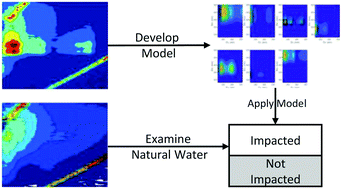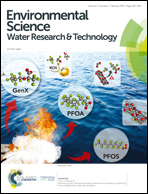Fluorescence excitation emission matrices for rapid detection of polycyclic aromatic hydrocarbons and pesticides in surface waters†
Abstract
Application of real-time fluorescence excitation emission matrices (EEM) as a tool for water quality assessment was investigated. A bench-scale fluorescence system with on-line monitoring capabilities was used to quantify several polycyclic aromatic hydrocarbons (PAHs) and pesticides in surface waters of Ontario, Canada. Parallel factors analysis (PARAFAC), an unsupervised multi-way analysis approach, was compared to a supervised peak-picking approach. Both approaches produced sensitive regression models capable of predicting contaminant concentration with mean absolute errors (MAE) that ranged from 0.032 to 0.293 μg L−1 for lake water, and 0.052 to 0.921 μg L−1 for river water. In addition, results showed accurate detection of contaminant concentrations exceeding 0.25 μg L−1. However, concentration and variability of natural organic matter (NOM) in natural waters presented unique challenges to peak-picking, PARAFAC, and regression analysis, which were mitigated by expert supervision as well as site-specific and timely calibration.



 Please wait while we load your content...
Please wait while we load your content...